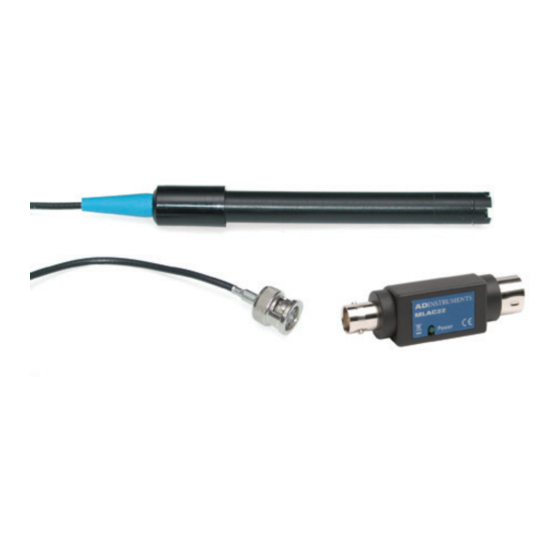
Table of Contents
Advertisement
Quick Links
INSTRUMENTS
AD
MLT1115 Galvanic Oxygen Electrode
Transducer Series
Description
The MLT1115 Galvanic Oxygen Electrode is
designed for measuring the concentration of oxygen
in aqueous solution.
Operation
Connect the electrode to the input connector of any PowerLab (or other recording
device having an input impedance of at least 1 MΩ). The unit may be connected directly
into a BNC input or alternately to a Pod Port via the supplied MLAC22 BNC to DIN
Smart Adaptor. The output in air-saturated deionized water should be 20 – 35 mV at
25 °C. The output will be larger at higher temperatures or in water saturated with pure
oxygen or Carbogen (5% CO
Note: Constant temperature must be maintained to obtain a meaningful signal.
Principle of Operation
The electrode comprizes a platinum cathode and a lead
anode connected via an internal 7.5 kΩ resistor. As oxygen
diffuses across the membrane and into the electrolyte
solution inside the electrode, the following reactions occur:
O
+ 2H
O + 4e
-
2
2
2Pb + 4OH
-
O
+ 2H
O + 2Pb →
2
2
For every molecule of oxygen consumed at the cathode,
four electrons are transferred from the anode. The potential
across the internal 7.5 kΩ resistor is proportional to this
current flow therefore, to oxygen concentration.
The rate of oxygen consumption by the electrode is given
by the formula:
d[O
]/dt = E/(4000RF)
2
where:
d[O
]/dt is the rate of oxygen consumption in mol/s
2
E is the output signal (potential) in mV
R is the value of the internal resistor, 7.5 kΩ
F is the Faraday constant, 96486.7 A·s/mol
, 95% O
).
2
2
→
4OH
-
→
2Pb(OH)
+ 4e
-
2
2Pb(OH)
2
at cathode
at anode
overall
Anode
Cathode
Cover cap,
cylinder
Membrane
Cover cap,
tip
Advertisement
Table of Contents

Summary of Contents for ADInstruments Transducer Series
-
Page 1: Principle Of Operation
INSTRUMENTS MLT1115 Galvanic Oxygen Electrode Transducer Series Description The MLT1115 Galvanic Oxygen Electrode is designed for measuring the concentration of oxygen in aqueous solution. Operation Connect the electrode to the input connector of any PowerLab (or other recording device having an input impedance of at least 1 MΩ). The unit may be connected directly into a BNC input or alternately to a Pod Port via the supplied MLAC22 BNC to DIN Smart Adaptor. -
Page 2: Operating Instructions
Operating Instructions Use the LabChart software to set your PowerLab input channel to a gain range of 50 mV. (If you are using another recording device adjust its input sensitivity to an appropriate range). A recording speed of 4 samples per second is more than sufficient and provides a good graphical display as the signal moves across the computer monitor. -
Page 3: Troubleshooting
Replacement of membrane tip and refilling of the electrode. old membrane cylinder 1. Unscrew the lower part of the electrode then 2. Remove old membrane and clean cylinder pull to remove tip from cylinder. and tip. new membrane 3.Place new membrane over top of tip and press 4. -
Page 4: Specifications
Prefix: FE) are warranted against defects in materials and workmanship for a period of 5 years from the date of purchase. Other PowerLab data acquisition units and ADInstruments manufactured Front-end and Pod Signal Conditioners, and Instruments are warranted of a period of 3 years from the date of purchase.














Need help?
Do you have a question about the Transducer Series and is the answer not in the manual?
Questions and answers